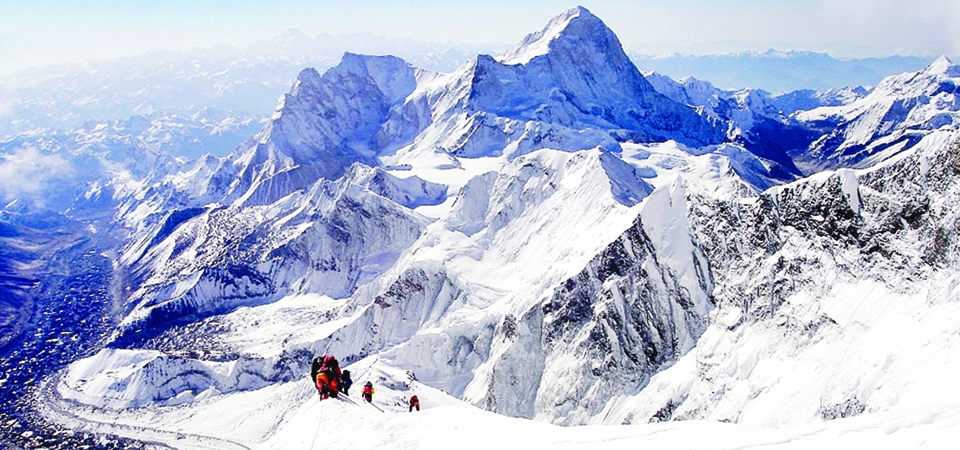New mountaineering rules introduced

By Aashish Mishra
Kathmandu, Mar. 11: As the spring mountaineering season draws closer, the Department of Tourism (DoT) has introduced 11 new rules that it claims are aimed at managing mountaineering-related activities.
Climbers are now prohibited from taking, circulating and publishing photos and videos of people not associated with them and their expeditions. “We came across cases of people and groups taking to the mountains and taking pictures and videos with intent to misuse. This rule seeks to curb such activities,” said Mira Acharya, director of the Mountaineering Division of the Department of Tourism.
She clarified that this was not a new rule but rather an extension of the provisions already made in the Criminal (Code) Act of 2017. “Our criminal code also prohibits people from snapping photos and filming videos of people without their consent. This rule builds upon that,” Acharya explained.
“Each climber is free to record still or moving images of themselves and their climb but they cannot take and share images of others or of non-mountaineering events like dead bodies,” Acharya said, adding, “People wishing to do so must obtain prior approval from the DoT.”
Climbing expeditions are required to inform and get permission from the Department before engaging in any task deemed unrelated to their climb. The mountaineering companies must also identify their clients and staff participating in the climb and submit their clients’ travel itineraries. Proof of the physical fitness of climbers is also required.
Nepal Mountaineering Association (NMA), the main alpine association of the country whose remit extends from promoting mountain tourism and climbing sports to protecting mountain environments and preserving cultural heritage of mountain people, welcomed the rules.
NMA President Santa Bir Lama told The Rising Nepal that these directives would enhance the professionalism of mountaineering and minimise the risks. “There were some valid problems in the mountaineering sector. Some people improperly joined expeditions without documentation and when mishaps occurred, it was hard to rescue them. Inexperienced and unfit climbers have caused
holdups and headaches for other more experienced people. Unregulated and unchecked climbing endangers people’s lives in the high Himalayan environment. So, these rules are a step in the right direction,” he said.
Lama also asked everyone to take the rubric positively. “Other countries also regulate mountaineering. It is high time Nepal did that too,” he said.
However, regarding the photos, Lama insisted on some manoeuvring space. While acknowledging that people have misused photos and videos to defame Nepal and smear its mountains, he said climbers should be allowed to cherish their feat. “Individuals pay good money to come scale our peaks so they should be allowed to click pictures. Some leeway should be given if other teams of climbers appear in their photos.”
Similarly, DoT has also directed air rescue companies to only transport rescued individuals to well-equipped hospitals for treatment. Director Acharya stated that this rule was brought at the request of the Ministry of Health and Population and believed that it could have been drafted to preserve the country’s international image. “Taking rescued tourists to shabby, poorly resourced health institutions might give the wrong impression about Nepal’s health infrastructure and capabilities. Perhaps that was the Ministry’s concern,” Acharya said.
But this rule disregards the fact that people requiring urgent care need to be taken to the nearest health institution, said Hari Dharel, chairman of Himalayan Rescue Association (HRA). “In emergency situations, the principle is that patients should be taken to the nearest healthcare facility for primary treatment and then referred to other hospitals if needed. But now, in complying with the rule, we should be looking for a modern hospital with all the amenities which might not be available near the mountain peaks,” he said.
Issues like this can be solved through discussions, Lama opined. “The Department and the Ministry of Culture, Tourism and Civil Aviation should be open to consultations. They should develop a framework for tour operators to take immediate action in emergency situations.”
The new rules, issued on Tuesday, apply to all peaks of the country that are open to mountaineers.
Recent News

Do not make expressions casting dout on election: EC
14 Apr, 2022
CM Bhatta says may New Year 2079 BS inspire positive thinking
14 Apr, 2022
Three new cases, 44 recoveries in 24 hours
14 Apr, 2022
689 climbers of 84 teams so far acquire permits for climbing various peaks this spring season
14 Apr, 2022
How the rising cost of living crisis is impacting Nepal
14 Apr, 2022
US military confirms an interstellar meteor collided with Earth
14 Apr, 2022
Valneva Covid vaccine approved for use in UK
14 Apr, 2022
Chair Prachanda highlights need of unity among Maoist, Communist forces
14 Apr, 2022
Ranbir Kapoor and Alia Bhatt: Bollywood toasts star couple on wedding
14 Apr, 2022
President Bhandari confers decorations (Photo Feature)
14 Apr, 2022









